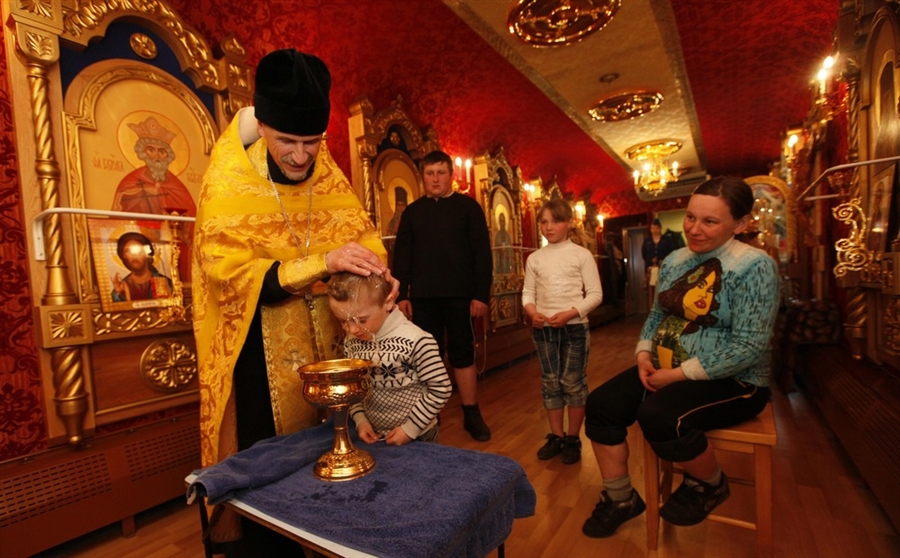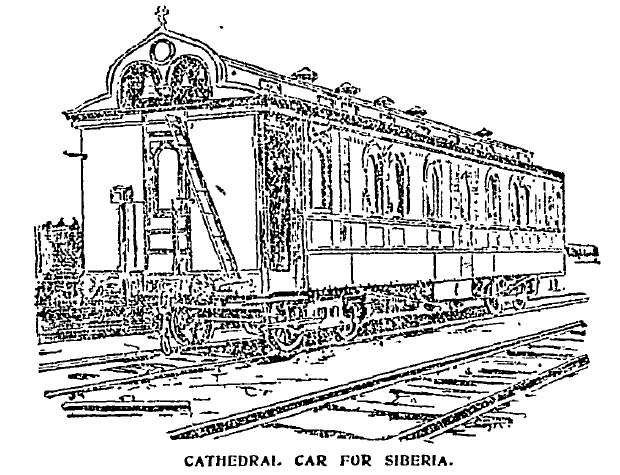
A Russian priest baptizes a family in the church car aboard the "mobile medical center" named for St. Luke of Simferopol. Photo from MSNBC.
On April 27, MSNBC published photos of a medical train in Russia that includes a full-blown Orthodox chapel (thanks to the excellent Byzantine, TX blog for the link). The train/clinic, named after the great surgeon-bishop St. Luke of Simferopol, travels to the far reaches of Siberia and has “a carriage that operates as a mobile Orthodox church.”
This seems like a pretty innovative idea, but actually, it’s well over a hundred years old. Way back in 19th century Russia, Orthodox missionaries began using a pretty much identical arrangement on the Trans-Siberian Railroad. From Boston Globe, December 29, 1896:
Cathedral Car for Bleak Wastes of Siberia.
American Missionary Idea Adopted by Greek Church Priests.
The missionary railroad car, invented by an American clergyman, has been taken up by the Russian church authorities, and four of these peripatetic disseminators are now regularly used in Siberia.
The Scientific American illustrates the style of cars used by the Greek missionaries in the bleak plains of Siberia. The car is moved from station to station, and the Siberian peasants liberally take advantage of the chances thus offered for attending services.
The Russian cars are fitted up with much of the rich barbarity and splendor of oriental art. The interiors of the walls are covered with painted images, and the car is provided with an altar, a tabernacle, candelabra, and the trappings pertaining to the ritual of the Russian Greek service.
Access to this traveling church is had in the usual way. At one end of the car is a chime of bells, and the top is surmounted by Greek crosses.
The idea was first used in the United States in sparsely settled parts of the country, such as Montana. It was readily seized upon by English missionaries, who ordered a number of these cars built for India.
Greek priests at once saw the advantage derived from the missionary car, and the Russian government commissioned a number of them for use in Siberia, where settlements are far between and the people can seldom attend divine services.
Here’s the illustration that accompanied that 1896 Boston Globe article:
A year earlier, the New York Times had referred to these mobile Russian Orthodox chapels as “churches on wheels.” I’ve been able to trace them back to at least 1886, when the journal Christian Union ran a note about a plan for “church cars” on trains in Russia.
I’m curious to know more about the modern-day church cars. Is the St. Luke of Simferopol train the only one with a chapel, or do other Russian trains include special cars for Orthodox worship? Also, I assume that the church cars made in the 19th century fell out of use after the Bolshevik Revolution — so who is responsible for re-introducing the idea? If any of our readers have more information, please let me know, and I’ll publish an update to this article.


The Russian army has various different church trucks and church tents; there has even been talk of inflatable churches for use by airborne forces.
After reading your article, I decided to do some further research. I found a Newsweek article by Damien Sharkov dated 11 May 2017 that also talks about the St. Luke train. It states that there are five medical trains with church cars currently in use, but unfortunately, does not say who re-introduced this idea or give the train names.